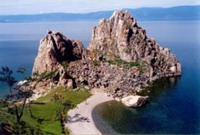Login form
Lake Baikal

Lake Baikal is in Southern Siberia in Russia, located between Irkutsk Oblast to the northwest and the Buryat Republic to the southeast, near the city of Irkutsk. It is also known as the "Blue Eye of Siberia". It contains more water than all the North American Great Lakes combined. At 1,637 meters (5,371 ft), Lake Baikal is the deepest lake in the world, and the largest freshwater lake in the world by volume, holding approximately twenty percent of the world's total surface fresh water. There are 336 rivers and streams flowing into Baikal. Over thousands of years, the basin was filled by water from rain, rivers and streams. Like Lake Tanganyika, Lake Baikal was formed in an ancient rift valley and therefore is long and crescent-shaped with a surface area (31,500 km²) less than half that of Lake Superior or Lake Victoria. Baikal is home to more than 1,700 species of plants and animals, two thirds of which can be found nowhere else in the world and was declared a UNESCO World Heritage Site in 1996. At more than 25 million years old, it is the oldest lake in the world.
Many mammals live in the Taiga including the brown bear, elk, moose and deer. Brown bears, the world's largest flesh-eating land mammal and the "Lords of the Taiga," are found throughout the region, and can be spotted along the shoreline. Elk and deer can be seen more readily, and during the winter, country people set up feeding troughs, almost treating them like domestic pets. Unfortunately, as in many parts of the world, poaching in Russia and around Baikal is a growing problem. During difficult economic times, this is especially with the local population, who hunt for meat as well as for the illegal trade in pelts and skins. The poaching of brown bear, deer, moose, elk and nerpa seal is common. Worldwide, the numbers of many of these animals, including brown bear, grow smaller each year. Those animals that do survive are faced with the problem of habitat destruction, a constant threat to their ability to live and reproduce in the wild
 Lake Baikal is home to the world's only fresh water seal. The mystery of how the Nerpa came to Baikal still baffles scientists. Apart from being a freshwater reservoir, Lake Baikal is hundreds of miles from any other sea or ocean. Most believe that thousands of years ago, the salt water of the Arctic Ocean stretched into the lower reaches of the Yenisey up to the mouth of the Angara. Many scientists agree that the seal belongs to the Tertiary fauna, and most likely migrated to the region during the early stages of the period when the Baikal Depression formed. It is thought that in search for food, the seals gradually migrated deeper into the mainland. There have been years when scientists have counted nearly one hundred thousand nerpa in and around the lake. Valued for their soft, warm pelts and fat, the seals have been hunted for thousands of years. Archeologists have discovered seal hunting weapons in the cave homes of early seal hunters.
Lake Baikal is home to the world's only fresh water seal. The mystery of how the Nerpa came to Baikal still baffles scientists. Apart from being a freshwater reservoir, Lake Baikal is hundreds of miles from any other sea or ocean. Most believe that thousands of years ago, the salt water of the Arctic Ocean stretched into the lower reaches of the Yenisey up to the mouth of the Angara. Many scientists agree that the seal belongs to the Tertiary fauna, and most likely migrated to the region during the early stages of the period when the Baikal Depression formed. It is thought that in search for food, the seals gradually migrated deeper into the mainland. There have been years when scientists have counted nearly one hundred thousand nerpa in and around the lake. Valued for their soft, warm pelts and fat, the seals have been hunted for thousands of years. Archeologists have discovered seal hunting weapons in the cave homes of early seal hunters.
Many kinds of fish make Baikal their home, and about 50 are suitable for eating. A delicacy worldwide, the salmon found in Lake Baikal is excellent. While locals use it in many of their favorite dishes, they also enjoy sturgeon, burbot, groundling, oilfish, and bullhead. Pike and perch are easy to catch and very popular. In addition, grayling and omul are highly recommended. Grayling contains two subspecies, white and black, and many locals prefer the rare white which is said to be larger and tastier. There are three types of Baikal omul inhabiting Baikal: Severobaikalsky, Posolsky and Selenginsky. Omul is also found in other Siberian waters and even in the northern parts of the Yenisey River.Lake Baikal is home to some interesting, but inedible fish. One in particular, the golomyanka, is one of only a few viviparous fish in the world. The small, transparent golomyanka and its cousin, the gobi, live in the lake's cold temperate zone. Since more than half of the golomyanka consists of fat, the fish easily drifts through the icy water. Twenty-seven species of gobi are unique to the lake and found nowhere else on Earth. In recent years, human environmental impacts have affected Baikal's fish population, particularly the omul. Lake Baikal's ecosystem was greatly altered by the construction of the Irkutsk Dam. Higher water levels devastated the population of Baikal bullheads, a small fish that serves as is the main source of nourishment for the omul and other large fish. The omul became even smaller, gradually thinner and increasingly infertile, a result of this environmental imbalance. To help mitigate the problem, from 1969-1975 the fishing of omul was prohibited. As the water level could not be altered, there was little more that could be done, and while the population of omul increased, the fish remains noticeably smaller.


